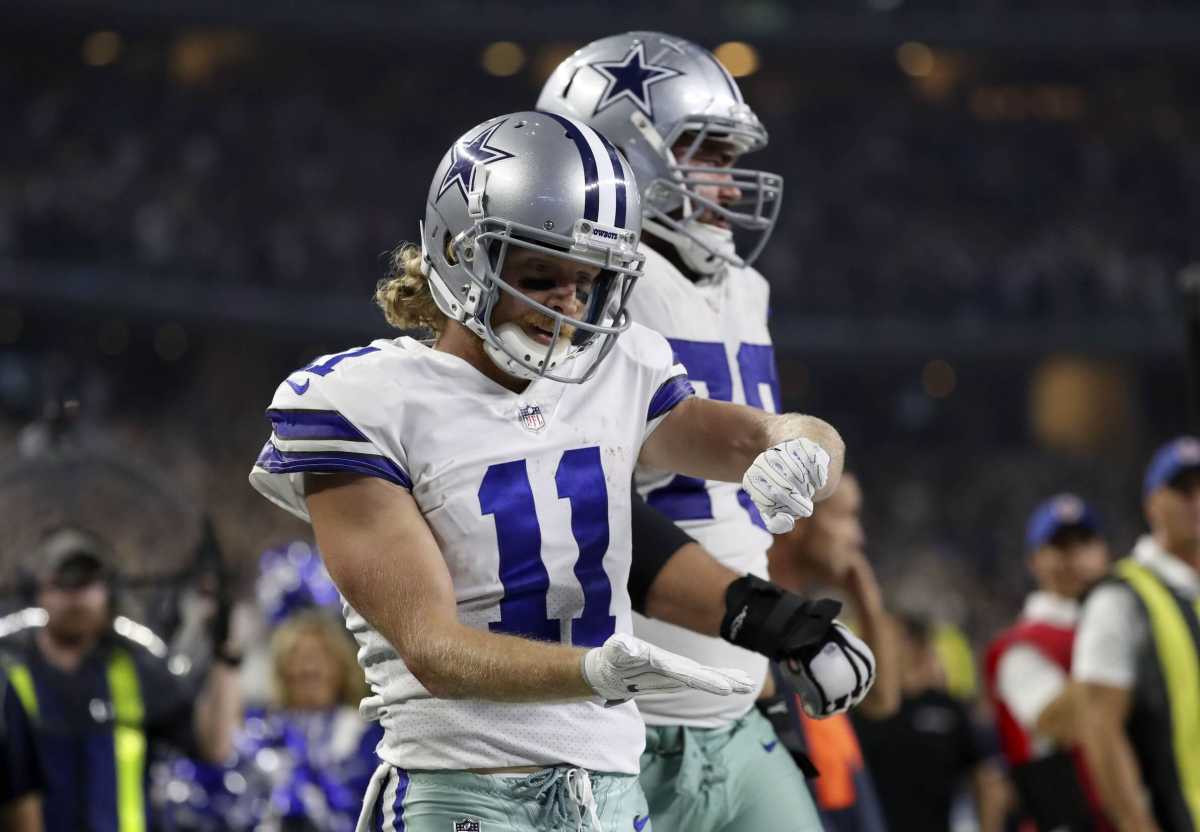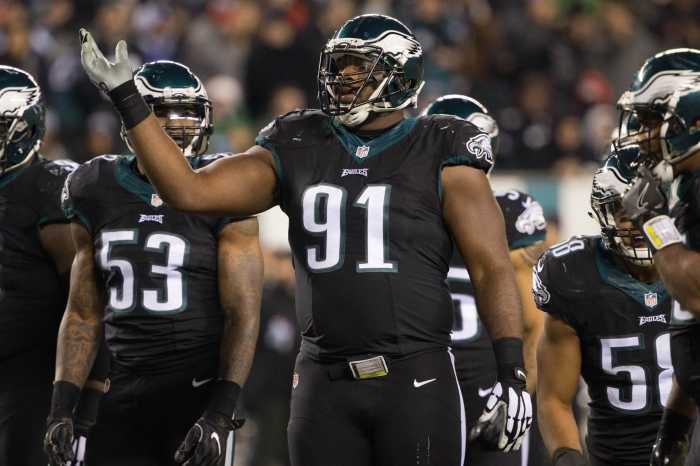While we all get into the full swing of the first full month of summer, most of us are counting the hours left in our football-less months. To ease the pain, this series will be taking a look at the Eagles’ NFC East opponents with true top and bottom line projections, full of arguable and opinion-based forecasts and rife with film study and statistics to back them up. We will begin with position-by-position analysis in an attempt to help you make your own educated decisions on your “buddy’s” favourite team. Continuing with perhaps our most tantalising opponent, and definitely our most hated, the Dallas Cowboys, I hope to provide you all with true best and worst case scenarios of each team’s offence and defence. Last article we discussed the Cowboys’ rushing attack, today we’ll be tackling their pass catchers — figuratively speaking. I have also included a bonus X-factor. Let’s get started.
Receivers and Tight Ends
Gone are Dez Bryant and Jason Witten, who have been staples of the Cowboys’ offence since they arrived in Arlington. Brice Butler took his annual 15 catches for 250 yards to Arizona in hopes of an expanded role. In their stead, new faces and uncertainty speckle a locker room with a lot to prove in 2018. Much will be expected of the two returning veterans Terrance Williams and Cole Beasley, both of whom will need to drastically improve on their 2017 seasons if they are to take up the reigns. The team that finished 26th in passing yards in 2017 will need to improve if they want to compete in a well-rounded and talented NFC.
One of the areas they will look to improve is splash plays. In 2016 the Cowboys had 39 passing plays of 20+ yards, and 34 in 2017. In both seasons they had 8 passing plays of 40+ yards. Last year alone, the New Orleans Saints had 72 passing plays of 20+ yards, and the Detroit Lions and Pittsburgh Steelers had 16 passing plays of 40+ yards. As a run-first offense, comparing them to the Saints, Lions and Steelers may be an unfair assessment. However, evidenced by Dallas’ speedy off-season acquisitions, they have identified a lack of deep passing plays as an issue. The group will also miss Dez Bryant’s contested catch ability. Bryant was the 3rd rated receiver on tight-window receptions per NFL writer Matt Harmon, placing 10th on yards per contested reception.
Williams is one of the presumed starters on the outside after turning in a 53 catch, 568 yard season for the Cowboys in 2017. He did not score last season. By all accounts he has the tools to be a productive receiver, but many would question his ability to be a number one option. In 2015, his best season, he registered only 52.5 yards a game on average. What we have seen of Terrance in previous years is likely indicative of what we will see in 2018. However, despite a dip in the last two years, Williams has averaged 14.6 yards per reception over his career – an ode to his ability to stretch the field. In each of his five years with the team he has never seen more than 78 targets, which is roughly half the number Dez Bryant sees in a full season. If Williams was able to maintain his catch rate from 2017 (67.9%) or 2016 (72.1%) facing Bryant-like targets, he would be rolling around in thousand yard seasons. That’s not the way it works though, is it? While Dak is insistent that the ‘Boys don’t ‘necessarily’ need a number one receiver, a step up from T-Will would sure help. Some have argued that a lack of a number one receiver will be good for the young QB, forcing him to read through his progressions. Believe that or not, 2018 will be a great test for Prescott.
Not much attention has been paid to the incredible disappearing act put on by Cole Beasley in 2017. Maybe it’s because the football powers that be recognised his 2016 season as a spurious one-off. Maybe it was hidden in the mess that was the 2017 Cowboys offence. Either way, the proof is in the pudding:
| Cole Beasley | Catches | Targets | Catch % | Yards | TDs | YAC |
| 2015 | 52 | 75 | 69.3% | 536 | 5 | 309 |
| 2016 | 75 | 98 | 76.5% | 833 | 5 | 381 |
| 2017 | 36 | 63 | 57.1% | 314 | 4 | 109 |
I include yards after catch because, after watching film of each Cowboys game in 2016 and 2017 – as agonising as it was – what jumps off the screen is the lack of plays made after the catch last year. This is where Beasley shines, and where the ‘Boys need him to contribute. This also alludes to the absence of quick screens in last season’s game plan. I found myself somewhat confounded by Jerry Jones’ decision to trade away what could have been a darling addition to the YAC club in Ryan Switzer. This should be taken as an indication to the faith the Cowboys front office has in Beasley bouncing back in 2018. Dallas fans should temper their expectations. While Beasley can definitely provide the offence with the necessary spark, it will likely be to the tune of 500 yards, not 1,000. Nevertheless, if Garrett can rededicate his team to the screen game, and find creative ways to get Beasley the ball, he could prove an important piece of the puzzle that was missing in 2017. Below are highlights from his game against Green Bay in 2016 and are a perfect example of how deadly Beasley can be when used properly.
The rest of the receiving room is filled with a ragtag group of castaways and underachievers looking for an opportunity to succeed in a wide open competition for snaps. What became evident with Dallas’ off-season signings is that they plan on becoming faster. So, without further ado, here is a long list of speedy hopefuls who will don the star in 2018, and Allen Hurns.
Hurns is a versatile, well-rounded receiver that can’t seem to keep himself off the injury list. He’s a better than average route runner and a solid contested catch receiver. The problem with Hurns, besides the injury concerns, is that he tends to have splash games, and can disappear. This may be more indicative of the offence he played for in Jacksonville, where it seemed that every week there was a new fantasy must-have receiver making his case. Projections for Hurns are all over the map, some have him pencilled in as the number two receiver in this offence, whereas recent reports state he is the “clear-cut” number one. These reports don’t mean much in June, but it could be indicative of playing time come September. One of the most notable facets of his game is his contested catch ability. The Cowboys undoubtedly brought him in to help replace some of the production and play-making lost with Dez Bryant’s departure. Both are steady handed, quarterback-friendly receivers. At his best in 2015, Hurns churned his way to a 1031 yard season on 105 receptions. Although he hasn’t eclipsed 500 yards since, he also hasn’t played a full season since his rookie year. If Hurns can stay healthy, the Cowboys may have found themselves a legitimate weapon.
https://www.youtube.com/watch?v=BaHww8tLlfM
This video is a compilation of Hurns in traffic. He’s better than most give him credit for.
Tavon Austin is a former first-round pick that has made a name for himself being consistently average. If you are like my pal who drafts Austin in his fantasy league every year, you’re probably tired of banging your head against the wall waiting for the speedster to actually do something that warrants his high selection. He is someone, however, who provides a constant threat of yards after catch, and can be an electric addition to the return game. Jason Garrett has already insisted that the Cowboys will find creative uses for Tavon in an attempt to get the ball in his hands, even making up a brand new title for the new addition. Some have even suggested he could find more snaps out of the backfield than at receiver this year. I find that unlikely, although I admit I don’t truly understand what a “web-back” is. Austin does have a history of moderate success running the football. In 2015 he totalled 434 rushing yards on 52 carries; both the most of his career. If nothing else, the 5’8” former first rounder provides a gadget player for Garrett to move around, which should at least provide some confusion for opposing defences.
Deonte Thompson is a 4.31 second 40 yard dash kind of player who has bounced around the league, but has found a niche for himself being a downfield threat in run first offences. Splitting his time between Buffalo and Chicago, he earned 555 yards on 38 receptions in 2017 – by far his best season. He has the ability to fight through contact, but isn’t known for his abilities after the catch. Dallas brass is optimistic that Thompson has finally hit his stride and is ready to become a consistent contributor as a third or fourth option.
Dallas also added two intriguing rookies who will compete for roster spots this off season. The first of which is their third round pick Michael Gallup. Gallup, 6’1” 205 pound Colorado State alum, has the size and the athleticism that makes scouts drool. He fell to the third round due to a talented draft class and his below-average college competition. Raw, physical, competitive and with a knack for finding the ball downfield, Gallup may be exactly what the doctor ordered to fill the void left by Dez Bryant. However, it will take some time. Nonetheless, Eagles fans won’t be happy to hear that this kid has sleeper written all over him, and hasn’t gotten the attention he deserves from the media outside of Dallas. While there are some knocks in his effort, especially when facing high-level opponents – queue his film versus Alabama – perhaps falling in the draft will provide him a reason to prove us all wrong. If nothing else, he should be a good red-zone receiver for years to come. Fun fact: Sports Info Solutions reports that Gallup caught 17 passes on 3rd down that went for first downs, which was 5th in the nation.
Pay attention to the two plays at 0:26. In the first play, Gallup demonstrates his ability with the ball in his hands – a strong, violent runner after the catch. The second play showcases his talent in adjusting to the deep ball.
The second compelling rookie in Dallas is undrafted rookie free agent KD Cannon. Cannon is a 5’11” 182 pound speed demon out of Baylor who ran a 4.41 at the NFL Combine. As Lance Zurlein so elegantly put it, the rookie ran a “route stick” in college: flies, stops, comebacks. He is far from a polished route runner, but damn is he fast. If he makes the 52-man roster, KD could push one of the veterans above for playing time later in the season.
| Jason Witten | Catches | Targets | Yards | Touchdowns |
| 2016 | 69 | 95 | 673 | 3 |
| 2017 | 63 | 87 | 560 | 5 |
The tight end position is a bit easier to figure: the Cowboys lose Jason Witten. Above are his stats from the 2016-2017 and 2017-2018 seasons. Witten’s last 1000 yard season was in 2012. The question is not whether the combination of Rico Gathers, Geoff Swaim and newly acquired rookie Dalton Shultz can cumulatively amass 600 yards receiving and 4 touchdowns, but instead, how much will the team miss Witten’s leadership if and when things turn sour? Per NFL Research, the average age on the squad is 25. Without the presence of a well-spoken and well-respected veteran, who will be ready to step into a leadership role? The Cowboys must be banking on one of their veteran wide-receiver acquisitions growing up in a hurry. In terms of on-field production, the Dallas fan base seems hell-bent on insisting Rico Gathers is a name to watch. I’m not convinced, but he sure does have the size (6’6″, 285lbs) and the athleticism (former basketball player at Baylor; ran a 4.66s 40 yard dash at his Pro Day) to entice lofty expectations. Swaim is the only one of the bunch that has actually caught an NFL pass, but his play hasn’t been particularly inspiring. Dalton Shultz has been tagged as an undersized blocking TE with limited play-making ability, but he has the intangibles (6’6″, 244lbs, 4.75s 40) to make plays over the middle. For his size, he is a very solid in-line blocker. Stanford has a knack for producing quality tight ends and their Head Coach David Shaw calls Schultz the most “complete” of the lot.
https://www.youtube.com/watch?v=WkttSnD3Pcc&feature=youtu.be&t=55 (Rico Gathers preseason TD)
At 0:55 you’ll see Rico Gather’s scoring ability. He effortlessly stacks on top of his cover and uses his body to shield his up-field shoulder. Textbook.
Best Case: Beasley returns to 2016 form and the rest of the wide receiver room individually realize their potential. Terrence Williams shows he can truly be a number one receiver, or at least he continues to be a serviceable option. He shakes off his end zone woes by finding pay dirt 5-6 times. Hurns turns in a close-to-thousand yard season and becomes Dak’s new best friend, showcasing his reliable hands. Michael Gallup runs true to form, dominating undersized corners and making the most of limited opportunities to start the season. He is an unbelievably tough cover in the red-zone. Come December, he could push Williams for snaps on the outside. Deonte Thompson provides much-needed veteran reliability and turns in a couple plays of his own. The return of Zeke forces defences to sell out to stop the run, creating ample space for the stable of speedsters to run amok in opposing secondaries and opening up room for Tavon Austin to operate. QB1 is finally able to showcase his beautiful deep ball with regularity. Most importantly, the whole group helps Dak out with some yards after catch and the offence benefits from some individual plays coming from someone not named Elliott. The tight end group does not miss Witten’s production, and even gets the spark from Rico Gathers Dallas fans have been calling for.
Worst Case: Tavon Austin is as mediocre as advertised. Williams is not a number one receiver, and never should be. Hurns goes down in the first 5 weeks, struggling to recover from nagging injuries that have plagued his professional career. Beasley again fails in his attempt to masquerade as a game-changing slot receiver, instead looking like a very average third option. Gallup needs time to develop, like most receiver prospects over the last few years. The group as a whole squanders opportunities to produce yards after the catch, and the ageing deep threats brought in during the off season have noticeably lost a step. The tight end group is one of the worst in the league, putting forth uninspired performance after uninspired performance. No receiver comes close to a 1000 yard season, but instead Dallas is left with a disheartening list of 600 yard or below seasons from their top guys. The offence continues to shy away from deep shots, and the room is void of possession receivers, other than the injured Hurns. Dak dips below 3,000 yards and sees another rise in interceptions.
X Factor: Scott Linehan’s play-calling will make or break the Cowboys’ offensive production in 2018. After receiving coach of the year honours in 2016, Garrett’s offensive game planning and situational play calling came under scrutiny last season. The aforementioned lack of effective screens, quick outs, drags and slants in the passing game encouraged defensive rushers to pin their ears back and permitted the secondary to give ample cushion to receivers. They were also unable to create big plays over the middle with the same regularity as they were in 2016.
QB option runs were not called nearly as often last year, despite having similar success when called. In both of the last two seasons, Dallas has failed to regularly stretch the field. When they did have success with the deep-ball it was regularly with the help of former Cowboy Dez Bryant. Dallas definitely has a deeper receiving corps this season, but they are relying on each receiver’s ability to realize their potential talent. Since Garrett took the reigns as Head Coach with the ‘Boys, the team has not been without a legitimate number one receiver. Even as an Offensive Co-Ordinator, his game plan has typically been to force-feed his top targets. Jane Slater of NFL Network reported during the season last year that: “the issue for several players is a predictable playbook.” Linehan will need to adjust and adapt for the 2018 season. Evidenced by the Eagles success last year, the new-age NFL necessitates a deep bevy of options.
Unlike Doug Pederson, Coach Garrett and Coach Linehan haven’t been known for adjustments to their playbook – evidenced by a reliance on Elliot, and Bryant before him, and Demarco Murray before him, and Witten before him, and a sprinkle of Miles Austin. In fact, since what seems to be the beginning of time, Dallas’ top receiver, or tight end, has almost double the targets of their next best receiver. There have also been times that the Cowboy’s situational play-calling has been called to question. For example, trailing Seattle 21-12 with 7:54 left on the clock, Dallas had the ball on the Seahawks 3-yard line. They did not hand the ball to Elliott once, but instead took a sack, a penalty, threw a 7-yard pass, and ended up kicking a 30-yard field goal. There’s really no excuse for that.
In terms of the running game, it seems like Garrett and Linehan would have to do all in their power to keep the train from rolling. However, we did see a slight drop in production last season. Despite having one of the most dominant rushing attacks in the NFL, Dallas saw a drastic drop in time of possession from 2016 (31:55/g, 2nd best) to 2017 (30:07, 14th). This is despite placing 5th in 3rd-down percentage (43%). A team that prides itself on controlling the clock and maintaining a lead simply cannot be successful placing 14th in time of possession. That is without calling Dallas’ defensive capabilities into question. They will also have to do better in the turnover column after finishing with -1 overall (17th). Even with a rookie QB and RB, the Cowboys were much better at keeping the ball in 2016.
There is also something to be said for the long list of recent rookie running backs having incredibly successful first seasons: 2017: Leonard Fournette, Kareem Hunt and Alvin Kamara; 2016: Ezekiel Elliot, Jordan Howard and Rob Kelley; 2015: Todd Gurley and Thomas Rawls; 2014: Jeremy Hill; 2013: Eddie Lacy and Zac Stacy; 2012: Alfred Morris and Doug Martin. Every single player on that list suffered a drop-off in their second season (barring the 2017 rookies). Rawls, Hill, Lacy, and Stacy have yet to replicate their rookie success.
I see Zeke bouncing back similar to Todd Gurley did last season; nonetheless, it seems that beginners luck is something that applies even in the NFL. More importantly, unless Offensive Coordinators are willing to get creative, rushing attacks become stagnant. The reactive nature of defensive scheming requires time to adjust to an opponent’s skill set. Even last season we saw Kansas City running back Kareem Hunt’s production decline towards the end of the season. In contrast, the Saints found innovative ways to get Alvin Kamara the ball late in the season, and the LA Rams were revitalised with an overhaul at the coaching position. That should put pressure on Jason Garrett to switch up his rushing attack. The Cowboys have the luxury of having one of, if not the best offensive line in football, and a new offensive line coach with plenty of professional experience. I would not be surprised to see Garrett’s name on the hot seat if the 2018 season does not go as planned.
Mandatory Credit: Kevin Jairaj-USA TODAY Sports



























